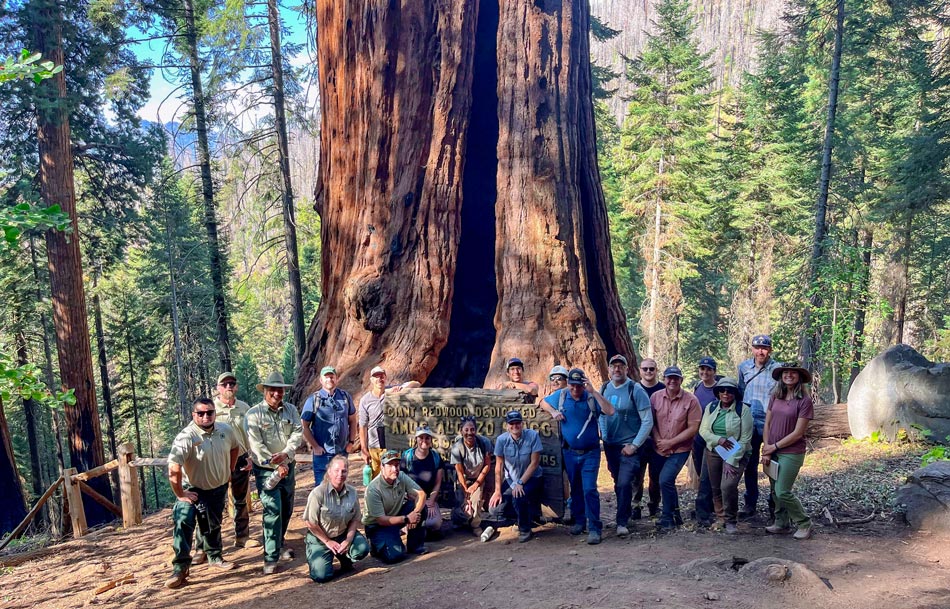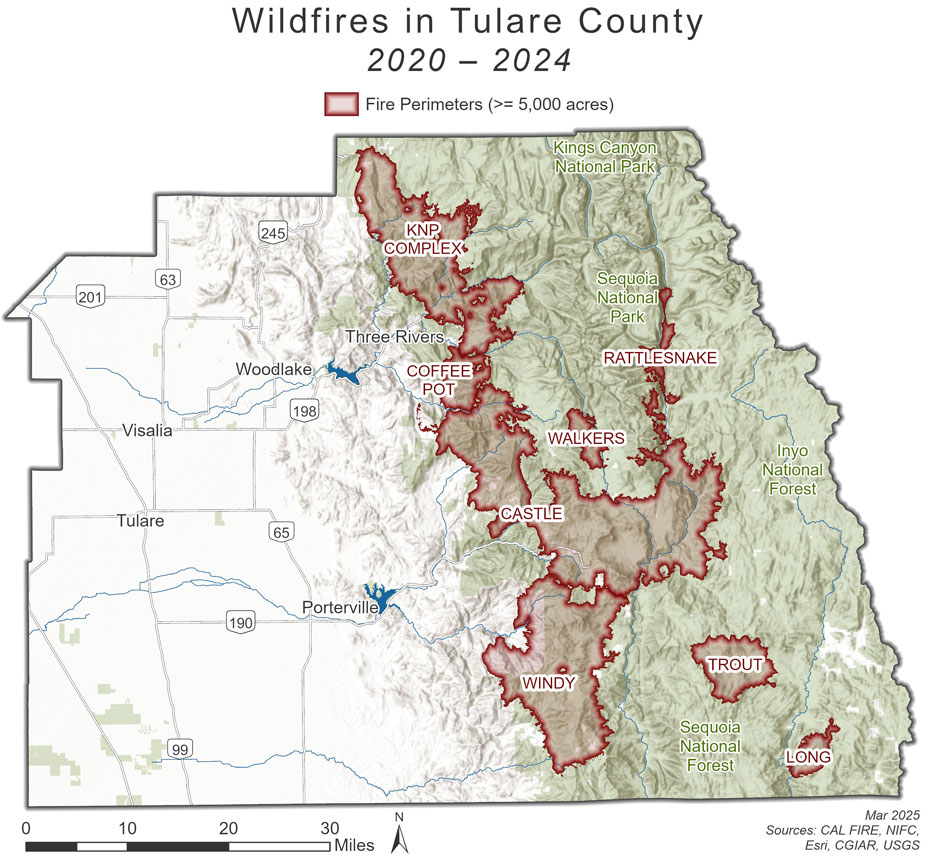Latest round of funding from SNC to help on-the-ground partners plan landscape-scale projects

Since landscapes and partnerships vary greatly across the state, creating large-scale wildfire resilience requires unique region-by-region solutions. What is needed in a southern California chaparral ecosystem is different than what may be needed in the northern California redwoods. That is why funding from the California Department of Conservation’s Regional Forest and Fire Capacity Program (RFFCP) has been so successful—it is flexible and designed to meet the needs of local and regional partnerships and efforts.
In the Sierra-Cascade, the Sierra Nevada Conservancy (SNC) was chosen as the RFFCP block grantee because of the regional nature of its work and close relationships with on-the-ground partners that result in customized solutions. The SNC invested more than $9 million in two rounds of previous RFFCP funding and just recently distributed an additional $10 million-plus to 25 strategic organizations to ensure regional wildfire-resilience projects are planned and, hopefully, implemented.
“Capacity building in the rural areas of the state is critical—it creates short-term leverage and long-term impact,” said Elissa Brown, partnerships and community support coordinator with the SNC. “It builds the strength of partners and encourages under-represented communities to raise concerns and move forward with their visions to help protect communities and restore health to our forests.”

Recent RFFCP highlights in the Sierra-Cascade
The distribution of the latest round of RFFCP funds, as highlighted by the following examples, showcases SNC’s relationship with regional partners and how they are successfully developing the capacity to restore resilience across the landscape.
Pit/Fall River RCD to expand reach in northern California
In the far northern part of the state, the Pit Resource Conservation and Fall River Resource Conservation District (Pit/Fall River RCD) received a recent RFFCP investment of $570,955 and will use the funds to work with landowners, tribes, fire safe councils, land trusts, and the U.S. Forest Service to cross ownership boundaries to greatly expand the footprint of existing fuel-reduction projects. With successful projects already completed in Shasta, Lassen, and Modoc counties, the Pit/Fall River RCD will also utilize funds to identify other high-priority areas within the wildland urban interface for future projects.
“The RFFCP allows the two RCDs to collaborate with and support our local partners, from wood-processing facilities, to fire safe councils, to the Pit River Tribe,” said Evan Watson, wildland urban interface coordinator with the Fall River RCD. “The RFFCP’s focus on building regional capacity means that the relationships being developed and projects being planned will pay off over the long term with regards to fire safety and forest health.”
Countywide fuels-reduction strategy in Tuolumne
Since the 2012 Rim Fire, a wide range of organizations and federal and state agencies have been engaged in fuel-reduction activities in Tuolumne County. With so many landowners, there can be a disconnect between projects and strategic plans to cohesively and effectively reduce overgrown fuels over the greater landscape. Through the $302,500 in funds from the RFFCP, Tuolumne County will develop a cross-jurisdictional database, organize stakeholders, and create a long-term strategy for forest-health and wildfire-resilience work across the entire county.
“The Regional Forest and Fire Capacity Program funding has been integral in developing and improving a countywide interactive platform for fuels-reduction activities and project prioritization within the county of Tuolumne,” said Sean Hembree, senior analyst—water and natural resources with Tuolumne County. “Together, the county and partners are working to create a robust data repository of past, current, and planned fuel-reduction projects.”

Working across public/private lands to protect giant sequoias
Over the past few years, wildfires have killed an estimated 20 percent of giant sequoias in California. Native only to certain regions of the Sierra Nevada, they were once thought impermeable to the negative effects of wildfire. In recent years, however, the severity of wildfires and a warming, changing climate have changed that perception. Increasing wildfire risk has become a bigger challenge, and addressing that challenge requires working across public and private lands and multiple counties in the Sierra-Cascade.
With the help of a $316,000 grant from the RFFCP, the Giant Sequoia Lands Coalition will accelerate protection of these iconic trees by hiring a full-time partnership coordinator who will manage outreach, fundraising, partnership development, as well as lead efforts to develop wildfire- and climate-resilient projects across multiple land ownerships. The coalition will also create a strategic roadmap that will help restore health and resilience within several giant sequoia groves.
“The RFFCP grant is a game-changer for Save the Redwoods League and the Giant Sequoia Lands Coalition, allowing us to accelerate critical restoration efforts across the iconic sequoia range. These resources will help us expand wildfire-resilience efforts, restore degraded groves, and ensure the long-term health of giant sequoias and their ecosystems. With this support, we’re strengthening the coalition’s ability to protect these irreplaceable forests for future generations,” said Ben Blom, director of stewardship and restoration for Save the Redwoods League.
Tulare County transitions from wildfire recovery to resilience
Tulare County leads the countywide forest health task force. Until recently, the county has mostly been in disaster response mode after several fires have greatly impacted the region. Looking to switch to long-term planning and collaboration with partners, the county will utilize $466,000 in funds to hire a consultant to assess current collaboration efforts, increase stakeholder outreach, and, most importantly, identify and prioritize community-protection projects before the next devastating fire roars through, especially in the Sequoia National Forest.
“Our efforts will strengthen wildfire recovery, build capacity, and create a solid project pipeline for Tulare County by increasing the pace and scale of work on the ground. The funding also supports strong partnerships, which are essential to collaborate seamlessly across jurisdictions,” said Doreen Alvez, grants specialist/forest health coordinator with Tulare County.

Building capacity continues to be vital
Throughout California, increasing the pace and scale of forest-health and wildfire-resilience projects is critical, especially in the Sierra-Cascade where overgrown forests and a changing climate have created a frightening combination for potential ignition. While funding the planning and implementation of projects is vital in and of itself, ensuring local and regional organizations have the capacity to complete the necessary work is paramount.
The RFFCP is ensuring that happens in many critical portions of the state by allocating funds to build up strategic organizations and tribal entities that know their respective areas the best and can get the much-needed work planned and implemented once further investments are secured.
“The results coming from the RFFCP in the Sierra-Cascade are collaborative planning and partnership of organizations and tribal entities that will help restore forest health and wildfire-resilience across the larger landscape. None of this incredible work would be possible without having the local and regional capacity to do so,” added Brown.
